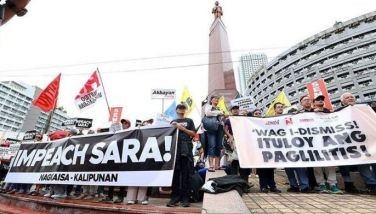BSP trims losses to P3B in 9 months
MANILA, Philippines – The Bangko Sentral ng Pilipinas (BSP) managed to trim its losses in the first nine months of the year on the back of higher revenues, particularly from interest income as well as gains on foreign exchange fluctuations.
Latest data from the central bank showed the net loss of the BSP fell 43.2 percent to P3 billion from January to September this year compared to the P5.28 billion loss in the same period last year.
The BSP reported its revenues grew 19.4 percent to P43.19 billion in the first nine months of the year from P36.18 billion in the same period last year due to higher interest and miscellaneous earnings.
Interest income jumped 19.3 percent to P28.42 billion from P23.83 billion, while miscellaneous income from regulatory fees paid by banks, among others, also surged 19.6 percent to P14.77 billion from P12.35 billion.
On the other hand, total expenses went up 6.5 percent to P53.84 billion in the first nine months of the year from P50.54 billion in the same period last year.
The BSP booked a gain of P7.65 billion on foreign exchange fluctuations in the first nine months of the year, or 15.8 percent lower compared to the P9.09 billion recorded in the same period last year.
The central bank posts gains or losses from fluctuations in foreign exchange rates arising from its foreign currency-denominated transactions.
These include the roll over or re-investments of matured foreign exchange investments with foreign financial institutions and foreign exchange-denominated government securities; servicing of matured foreign exchange obligations of the BSP; and maturity of derivatives instruments.
In 2012, the BSP booked a record loss of P95.38 billion due mainly by the buildup in the amount of cash parked in its vault.
The central bank uses the special deposit account (SDA) facility as a tool to siphon excess cash from the economy as part of its mandate to protect consumers’ purchasing power by keeping prices stable.
The BSP’s Monetary Board sets the SDA rates depending on their assessment of domestic liquidity conditions.
Expenses of the central bank increases when more money are parked in the SDA facility due to higher rates and more money are flushed into the economy once the rates are reduced.
The BSP is set to launch the interest rate corridor (IRC) system in the second quarter of next year to enhance the effectiveness of monetary policy that could create short-term volatility due to the migration of fund from the SDA facility to higher yielding term auction deposit facility.
The IRC system calls for the shift to the use of floor (SDA rate) and ceiling rates (overnight lending rate) for short-term financing to be determined through the auction of seven- and 28-day deposit maturities initially set at once a week.
- Latest
- Trending

























